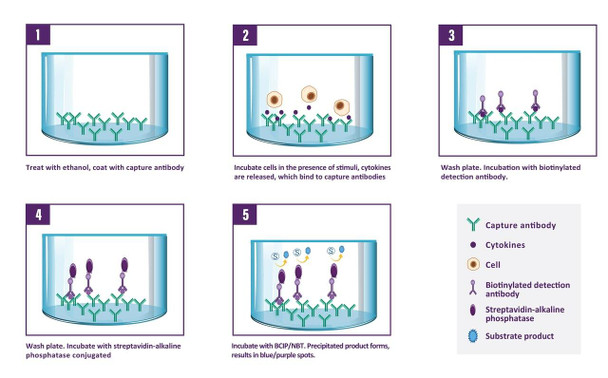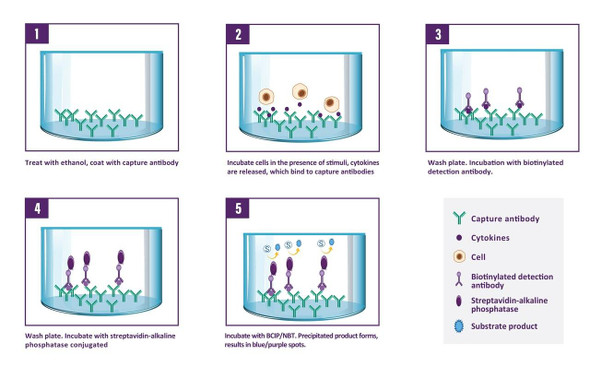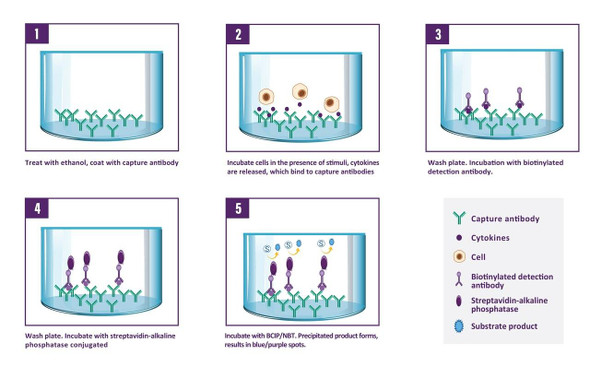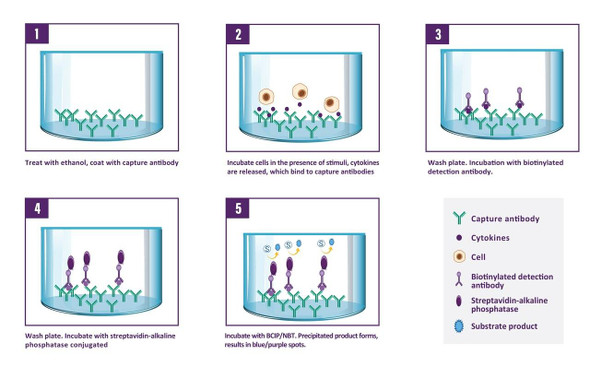Description
Human IL-5 ELISpot Pair
Assay Genie ELISpot is a highly specific immunoassay for the analysis of IL-5 production and secretion from T-cells at a single cell level in conditions closely comparable to the in-vivo environment with minimal cell manipulation. This technique is designed to determine the frequency of IL-5 producing cells under a given stimulation and the comparison of such frequency against a specific treatment or pathological state. Utilising sandwich immuno-enzyme technology, Assay Genie ELISpot assays can detect both secreted IL-5 (qualitative analysis) and single cells that produce IL-5 (quantitative analysis). Cell secreted IL-5 is captured by coated antibodies avoiding diffusion in supernatant, protease degradation or binding on soluble membrane receptors. After cell removal, the captured IL-5 is revealed by tracer antibodies and appropriate conjugates.
| Product type: | ELISpot Pairs |
| Size: | 10 x 96 Assays |
| Target species: | Human |
| Specificity: | Recognizes natural human IL-5 |
| Incubation: | |
| Kit content: | Assay Genie ELISpot matched antibody pairs are extensively validated and include pre-titrated capture antibody and biotinylated detection antibody. Antibodies are supplied in quantities sufficient for 10 x 96 samples. |
| Synonyms: | N/A |
| Uniprot: | P05113 |
A capture antibody highly specific for IL-5 is coated to the wells of a PVDF bottomed 96 well microtitre plate either during kit manufacture or in the laboratory. The plate is then blocked to minimise any non-antibody dependent unspecific binding and washed. Cell suspension and stimulant are added and the plate incubated allowing the specific antibodies to bind any IL-5 produced. Cells are then removed by washing prior to the addition of Biotinylated detection antibodies which bind to the previously captured IL-5. Enzyme conjugated streptavidin is then added binding to the detection antibodies. Following incubation and washing, substrate is then applied to the wells resulting in coloured spots which can be quantified using appropriate analysis software or manually using a microscope.
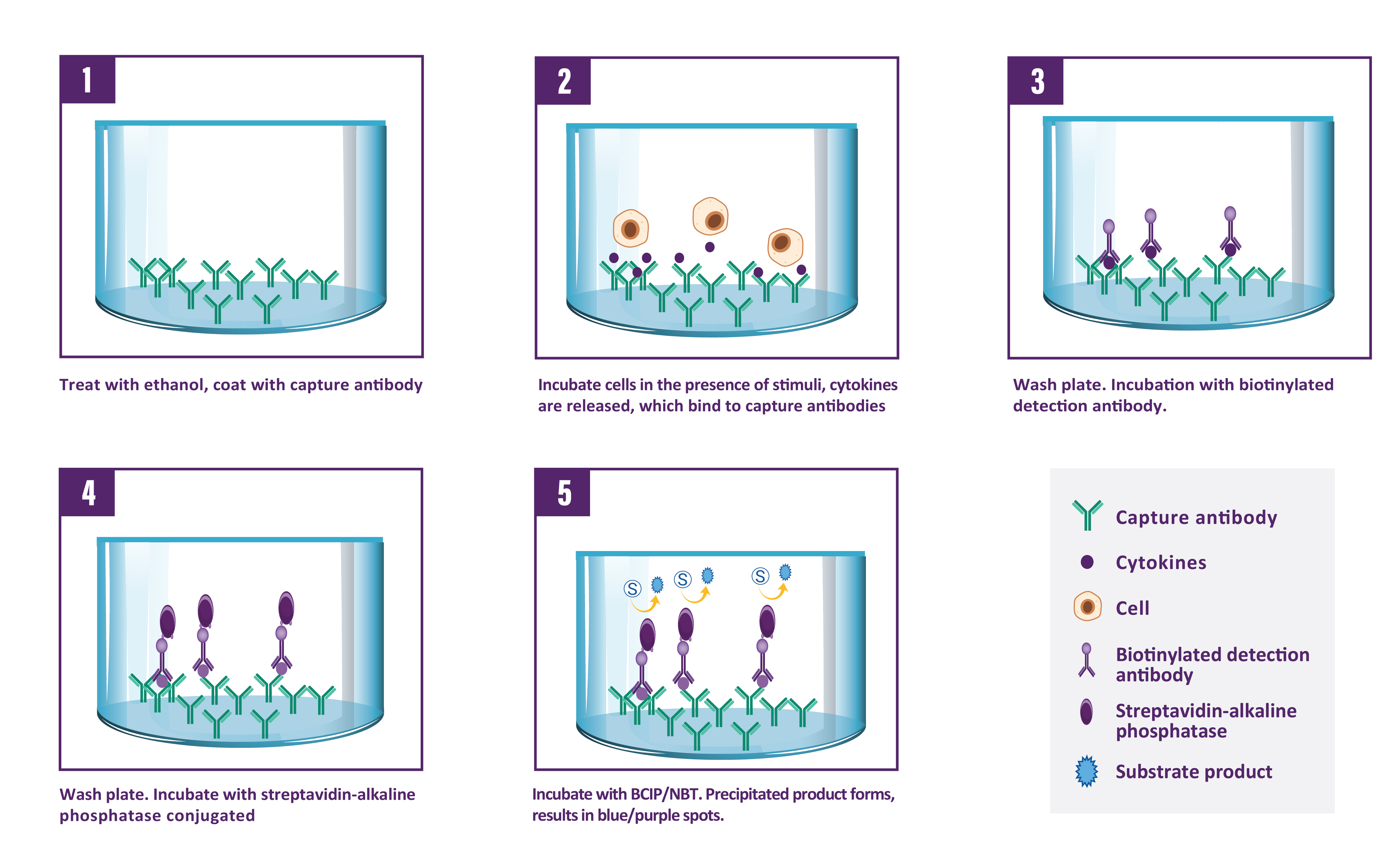
| Step | Procedure |
| 1. | Add 100 µl of PBS 1X to every well. |
| 2. | Incubate plate at room temperature (RT) for 10 min. |
| 2. | Incubate plate at room temperature (RT) for 10 min. |
| 3. | Empty the wells by flicking the plate over a sink & gently tapping on absorbent paper. |
| 3. | Empty the wells by flicking the plate over a sink & gently tapping on absorbent paper. |
| 4. | Add 100 µl of sample, positive and negative controls cell suspension to appropriate wells providing the required concentration of cells and stimulant. |
| 5. | Cover the plate and incubate at 37°C in a CO2 incubator for an appropriate length of time (15-20 hours). Note: do not agitate or move the plate during this incubation. |
| 6. | Empty the wells and remove excess solution then add 100 µl of Wash Buffer to every well. |
| 7. | Incubate the plate at 4°C for 10 min. |
| 8. | Empty the wells as previous and wash the plate 3x with 100 µl of Wash Buffer. |
| 9. | Add 100 µl of diluted detection antibody to every well. |
| 10. | Cover the plate and incubate at RT for 1 hour 30 min. |
| 11. | Empty the wells as previous and wash the plate 3x with 100 µl of Wash Buffer. |
| 12. | Add 100 µl of diluted Streptavidin-AP conjugate to every well. |
| 13. | Cover the plate and incubate at RT for 1 hour. |
| 14. | Empty the wells and wash the plate 3x with 100 µl of Wash Buffer. |
| 15. | Peel of the plate bottom and wash both sides of the membrane 3x under running distilled water, once washing is complete remove any excess solution by repeated tapping on absorbent paper. |
| 16. | Add 100 µl of ready-to-use BCIP/NBT buffer to every well. |
| 17. | Incubate the plate for 5-15 min monitoring spot formation visually throughout the incubation period to assess sufficient colour development. |
| 18. | Empty the wells and rinse both sides of the membrane 3x under running distilled water. Completely remove any excess solution by gentle repeated tapping on absorbent paper. |
| 19. | Read Spots: allow the wells to dry and then read results. The frequency of the resulting coloured spots corresponding to the cytokine producing cells can be determined using an appropriate ELISpot reader and analysis software or manually using a microscope. Note: spots may become sharper after overnight incubation at 4°C in the dark. |
| UniProt Protein Function: | IL5: Factor that induces terminal differentiation of late- developing B-cells to immunoglobulin secreting cells. Belongs to the IL-5 family. |
| UniProt Protein Details: | Protein type:Secreted; Secreted, signal peptide; Cytokine Chromosomal Location of Human Ortholog: 5q31.1 Cellular Component: extracellular region; extracellular space; intracellular Molecular Function:cytokine activity; growth factor activity; interleukin-5 receptor binding; protein binding Biological Process: activation of MAPKK activity; axon guidance; cytokine and chemokine mediated signaling pathway; epidermal growth factor receptor signaling pathway; fibroblast growth factor receptor signaling pathway; inflammatory response; innate immune response; insulin receptor signaling pathway; MAPKKK cascade; nerve growth factor receptor signaling pathway; positive regulation of B cell proliferation; positive regulation of eosinophil differentiation; positive regulation of immunoglobulin secretion; positive regulation of JAK-STAT cascade; positive regulation of peptidyl-tyrosine phosphorylation; positive regulation of transcription factor activity; Ras protein signal transduction; small GTPase mediated signal transduction; vascular endothelial growth factor receptor signaling pathway |
| NCBI Summary: | This gene encodes a cytokine that acts as a growth and differentiation factor for both B cells and eosinophils. The encoded cytokine plays a major role in the regulation of eosinophil formation, maturation, recruitment and survival. The increased production of this cytokine may be related to pathogenesis of eosinophil-dependent inflammatory diseases. This cytokine functions by binding to its receptor, which is a heterodimer, whose beta subunit is shared with the receptors for interleukine 3 (IL3) and colony stimulating factor 2 (CSF2/GM-CSF). This gene is located on chromosome 5 within a cytokine gene cluster which includes interleukin 4 (IL4), interleukin 13 (IL13), and CSF2 . This gene, IL4, and IL13 may be regulated coordinately by long-range regulatory elements spread over 120 kilobases on chromosome 5q31. [provided by RefSeq, Jul 2013] |
| UniProt Code: | P05113 |
| NCBI GenInfo Identifier: | 124341 |
| NCBI Gene ID: | 3567 |
| NCBI Accession: | P05113.1 |
| UniProt Secondary Accession: | P05113,Q13840, |
| UniProt Related Accession: | P05113 |
| Molecular Weight: | 15,238 Da |
| NCBI Full Name: | Interleukin-5 |
| NCBI Synonym Full Names: | interleukin 5 |
| NCBI Official Symbol: | IL5Â Â |
| NCBI Official Synonym Symbols: | EDF; TRF; IL-5Â Â |
| NCBI Protein Information: | interleukin-5 |
| UniProt Protein Name: | Interleukin-5 |
| UniProt Synonym Protein Names: | B-cell differentiation factor I; Eosinophil differentiation factor; T-cell replacing factor; TRF |
| Protein Family: | Interleukin |
| UniProt Gene Name: | IL5Â Â |
| UniProt Entry Name: | IL5_HUMAN |

